Vegan Malai Kofta is a creamy, delicious Indian restaurant style dish. Tofu and potato kofta balls are dunked in a silky and perfectly spiced tomato onion sauce. Serve with basmati rice or vegan naan for the perfect Indian dinner.
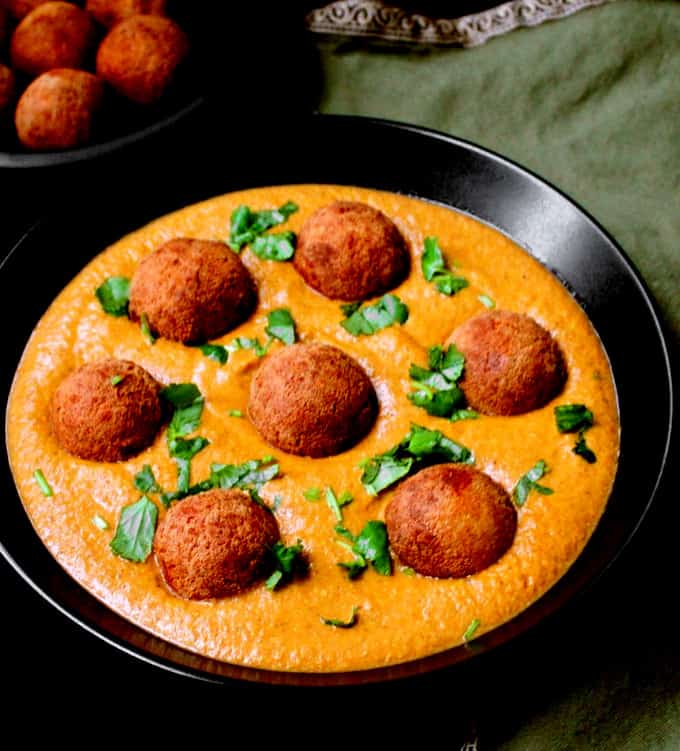
Malai kofta is a dazzling, vegetarian Indian dish: deep-fried, delicate balls of cheese, or kofta, float in a subtly but expertly spiced creamy and orange-gold sauce.
Here, I will show you how to veganize this dish fit for royalty with no loss of flavor. In fact, even if you're not vegan and you make this vegan malai kofta, you will become a convert!
Table of Contents
What is malai kofta?
Koftas can be loosely described as meatballs, and they are often made with lamb or beef or chicken meat in India (check out these easy Indian style vegan koftas). However, vegetarian versions of kofta, like malai kofta, made with paneer, a fresh Indian cheese, and khoya, a reduction of milk, are just as -- or perhaps more -- popular.
Koftas are not a concept native to India. Rather, like other popular Indian dishes like Vegetable Biryani, Samosa, Gulab Jamun and Navratan Korma, which have heavy central Asian and Persian influences, koftas originated in the kitchens of the Mughals, Muslim invaders from central Asia who went on to rule a large part of northern India for nearly two centuries.
The Mughals were gone from India by the 19th century, but the food they popularized had already permeated and mingled with local north Indian cuisine, and it stayed put. Today, anyone can eat dishes like Malai Kofta at a north Indian restaurant anywhere in the world.
Well, anyone except vegans.
Veganizing malai (cream) kofta
Given that the two key ingredients in a malai kofta are milk and paneer, making a vegan malai kofta can appear to be a difficult job. But more than a decade ago, when I first developed this recipe, I came up with two substitutions that worked really well: tofu and cashews. For the creamy, spicy, orange curry sauce I used cashew cream.
No Indian I've served this vegan malai kofta to has ever guessed it's vegan--it is quite perfect and full of flavor. Over the years so many of you have also made it, loved it, and come back to tell me about it.
A lush, restaurant-style malai kofta curry
- Tasty. This vegan malai kofta curry is possibly going to be the most delicious Indian dish you've ever eaten, it's that good.
- Creamy and luxurious. The mouthfeel of the koftas and the curry are just right, especially when paired with a naan or rice.
- Kid-friendly. The recipe has spices but it is not a spicy dish, thanks to all the cashew cream and tofu, and those pretty, deep-fried kofta balls are a kid magnet.
- Foolproof. This malai kofta curry involves a few steps but it is an easy enough recipe if you follow instructions.
Fantastic recipe, have made it so many times now and it's always a hit. - Sophie
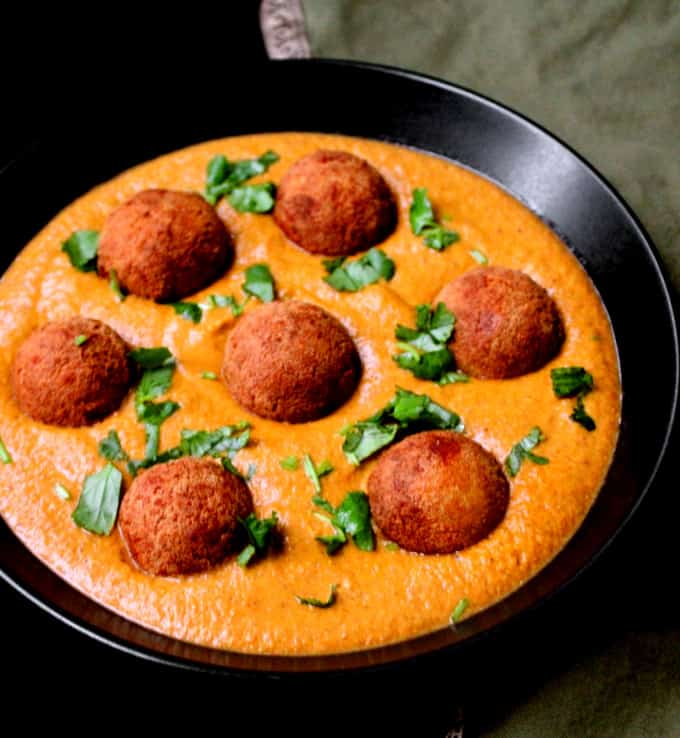
Expert tips
- If you're familiar with Indian food, you likely know malai is the Hindi word for cream. But malai kofta balls do not actually have any malai or cream in them, only the sauce does. The ingredients for the koftas cannot be fluid, as cream is, because they have to hold together in a ball firm enough to fry. So Indian cooks usually use khoya instead of "malai" in the kofta balls. Khoya is made by boiling milk until all of the liquid has evaporated and all that remains are the thick milk solids. Paneer and a small amount of potato is added to the khoya to make the kofta balls. In my vegan version, I sub the paneer with tofu, the khoya with cashews, and thank heavens a potato is already vegan. 😉 For the cream sauce, instead of cream or malai, I use cashew cream.
- This is a recipe designed for royalty, so the flavors here have to be just right -- not too spicy, not too overbearing, but delicate and voluptuous at the same time. So. Don't go overboard with the quantity of spices.
- You want all of the ingredients in the kofta balls to be really, really creamy while remaining solid, so make sure everything is broken down really fine without any water added. Grate the tofu and then give it a turn in the food processor to make sure it's as smooth as possible.
- You will need to process the raw cashews into a really fine powder, again without any water. The cashews help add richness to the kofta balls, the richness khoya would bring, so don't skip them unless you are nut-free.
- You need very little potato in the kofta balls, because the potato is simply there to bind, not to add flavor. Too much potato will result in a dish of potato dumplings floating in the curry, and that's not what you're going for. Use one medium potato, boiled and peeled, for this dish. You also don't need too much cornstarch or tapioca starch, depending on which one you're using. You want these balls to be creamy, not doughy, and the starch, like the potato, is just a binder.
- After adding the spices and cornstarch, the kofta balls should hold together firmly and shouldn't fall apart when you add them to the oil. Fry one ball first to make sure it holds, but if it doesn't, add more cornstarch and proceed.
- Koftas are often stuffed with a little surprise inside, like nuts or raisins. I added raisins because I like the bit of sweetness here, but if you want to add nuts, use chopped pistachios and/or cashews and you can certainly add both nuts and raisins.
- If deep frying scares you, you could put your kofta balls in an air fryer or the oven, but you won't get the same great crust or the flavor. My advise is to deep fry and eat in moderation. This is by no means an unhealthy recipe and it's filling, so I doubt you'll want to eat all of it at one go.
- The curry sauce that goes with the kofta is really simple to make, and it comes together quickly. You will need to process the sauce in the blender to make it really creamy, and then strain it for best results.
- I like the sauce thick here, but you can thin it out to your liking and for an even smoother texture. Use water to thin it out.
- The creaminess of the sauce comes from cashews and pumpkin seeds, which are both traditionally used in India. These also take away the need to add any cream to the sauce. Now here's a big DON'T. Unless you're nut-free and absolutely can't use cashews or pumpkin seeds, don't use coconut milk to add creaminess to the sauce--a mistake cooks unfamiliar with the nuances of Indian cuisine often make. Here's the rule of thumb to remember: in south India, cooks use coconut milk to add creaminess to recipes. In north India, they use dairy products like butter and cream. Malai kofta is unequivocally north Indian and the strong flavor of coconut milk simply does not work here.
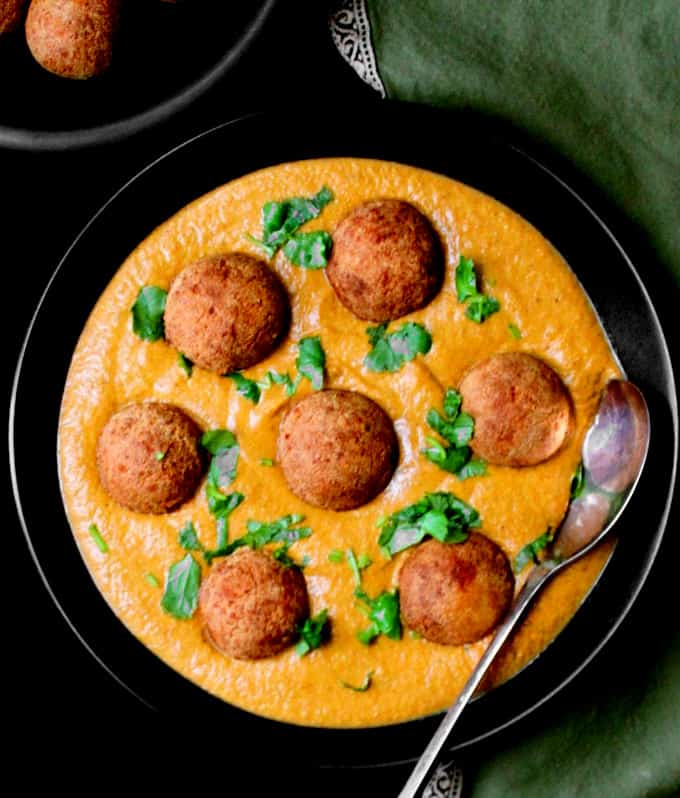
Ingredients for vegan malai kofta
For the kofta balls:
- Super firm tofu or high protein tofu. I strongly recommend using super firm tofu, also called high protein tofu, in this recipe because it helps hold the kofta balls together nicely. You can, however, use extra firm tofu--make sure you squeeze out as much of the moisture as you can before using.
- Cashews: Cashews provide the creaminess in the kofta, standing in for the khoya, or the milk reduction, that's usually such an integral part of malai kofta. You can use pumpkin seeds if nut-free.
- Cornstarch or tapioca starch: This will help bind the koftas together.
- Potato: Potato is usually used in malai koftas, and as it's divinely vegan we don't need to sub it here.
- Golden raisins (optional). For stuffing in the kofta balls. You can alternatively use chopped nuts.
- Ginger. For aromatic flavor.
- Green chili peppers, like serrano or jalapeno: For spice.
- Vegetable oil. For frying the kofta.
- Salt
For the malai sauce
- Spices. Green cardamom pods), cloves, cinnamon, cayenne, turmeric, cumin seeds, ground coriander and garam masala.
- Onions: Try and use shallots or red onions, but if you have neither yellow onions will do.
- Ginger and garlic. For flavoring the aromatic, delicate sauce.
- Tomatoes: For the curry base,
- Cashews: These will make the kofta curry creamy. Don't be tempted to sub with coconut milk, which will alter the flavor. If you are nut-free, however, you can use more pumpkin seeds. Replace the cashews with an equal amount of unsalted, unroasted pumpkin seeds in addition to the ¼ cup of pumpkin seeds that are already in the sauce recipe.
- Pumpkin seeds: These, too, contribute creaminess to the gravy. If you are nut-free, sub the cashews as well with an equal quantity of pumpkin seeds.
- Kasoori methi (dry fenugreek leaves): Kasoori methi adds a nice, restaurant-style finish to this dish and its slight bitterness ties all the different flavors in this kofta curry nicely together.
- Sugar (optional). To balance out the flavors.
- Salt to taste
- Cilantro: For garnish
What to serve with vegan malai kofta
Vegan malai kofta goes beautifully with an Indian bread, like a vegan naan or roti.
You can also serve it with an easy jeera rice for a fantastic meal. Serve a vegan raita on the side.
For dessert serve a classic Indian Mughlai dessert like vegan gulab jamun or vegan malpua.
More restaurant style Indian recipes
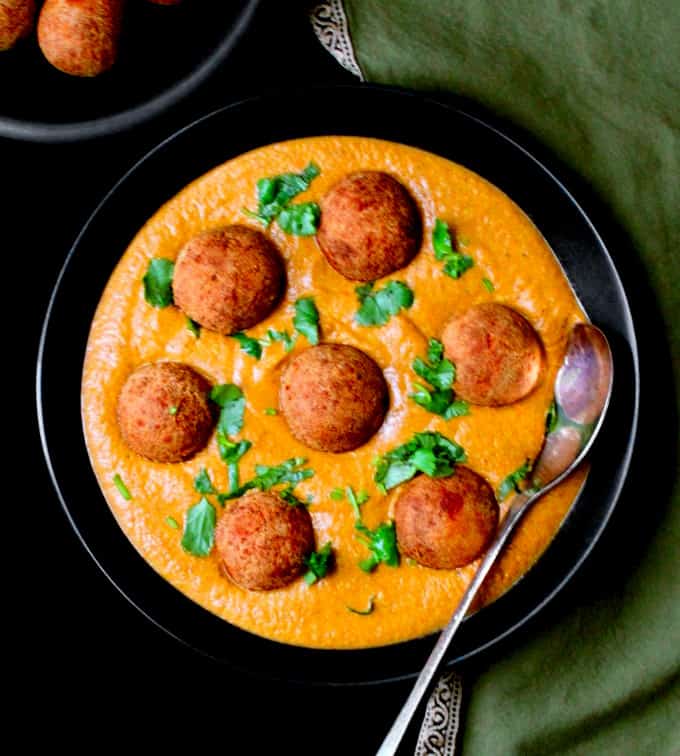
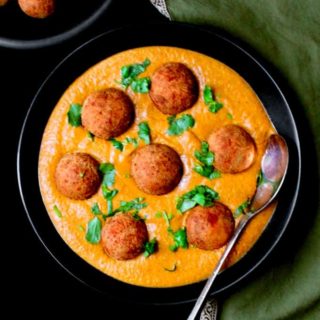
Vegan Malai Kofta Recipe
Equipment
- Small wok or saucepan or deep fryer
- Dutch oven or saute pan
Ingredients
For the vegan malai kofta:
- 16 oz super firm tofu (also called high protein tofu. Grate the tofu and then pulse five to six times in a food processor)
- ½ cup raw cashews (finely ground in a blender or food processor without adding any water)
- 1 medium potato (boiled, peeled and grated)
- 1 green chili pepper (like serrano or jalapeno. Deseed for less heat and mince really fine. Add more or less based on your personal preference)
- 1 teaspoon ginger (grated fine)
- 2 tablespoon cornstarch (or tapioca starch)
- Salt to taste
- 32 golden raisins (optional, for stuffing the kofta dumplings. You can also use finely chopped nuts like pistachios or cashews)
- Vegetable oil for deep frying You need enough oil to immerse the balls, which are about 1.25 inches in diameter.
For the malai curry:
- 1 tablespoon avocado oil or any neutral oil
- 1 teaspoon cumin seeds
- 3 green cardamom pods
- 3 cloves
- ½ inch stick cinnamom
- 1 large yellow onion
- 3 cloves garlic (minced or crushed into a paste)
- ½ inch piece ginger (finely grated or minced)
- ¼ teaspoon turmeric
- ½ teaspoon cayenne (use more or less based on your personal preference)
- ½ tsp (heaping) ground coriander
- 3 medium tomatoes (finely chopped)
- ½ cup raw cashews
- ¼ cup pumpkin seeds
- 2 tablespoon kasoori methi (dry fenugreek leaves, crushed in your palms)
- ½ teaspoon garam masala
- 1 teaspoon sugar (optional)
- 2 tablespoon cilantro (chopped, for garnish)
Instructions
Make the kofta:
- Place the tofu, cashews, potatoes, cornstarch, minced chili peppers, ginger and salt in a bowl and knead until the dough holds together. The dough will be soft but it will hold together. Form 16 smooth balls with the dough. If you're stuffing raisins into the kofta dumplings, flatten the dough first in your palm a little, place two raisins in the middle, then shape into a ball.
- Heat oil in a small wok or saucepan, until a small piece of the kofta dough added to the oil sizzles immediately and rises to the top. Deep fry the kofta balls in batches on a medium flame until they are deep golden on the outside.
- Place the kofta balls in a large serving bowl.
Make the curry sauce:
- Heat oil in a Dutch oven or large saucepan. Add the cardamom, cloves and cinnamon
- Add the onions and saute until the onions are soft and just beginning to turn color.
- Add the ginger and garlic, saute for no more than 30 seconds, then add in the turmeric, cayenne and coriander powders. Stir to mix.
- Add the tomatoes and cook until the tomatoes are pulpy and broken down, then add in the cashew nuts, pumpkin seeds and kasoori methi and mix well. Turn off the heat.
- Remove the entire mixture to the blender, add two cups of cold water and process to a really smooth paste. You can strain the sauce at this point for a really smooth texture or use as is.
- Add the sauce back to the pan and bring it back to a boil over low heat. If it's too thick to your liking, dilute with more water. Mix in the garam masala and add salt. Stir in the sugar if using, and turn off the heat.
- Pour the hot sauce over the kofta balls, and serve immediately.
Notes
- You want all of the ingredients in the kofta balls to be really, really creamy while remaining solid, so make sure everything is broken down really fine without using any water. I grate the tofu and then give it a turn in the food processor to make sure it's as smooth as possible. I really recommend using super firm tofu or high protein tofu for this dish if possible. Extra firm tofu is not as desirable, but if it's your only option, make sure you press out most of the water.
- You will need to process the raw cashews into a really fine powder. The cashews help add richness to the kofta balls, the richness khoya would bring, so try not to skip them. If you're nut-free, you can leave them out.
- Don't overwhelm the recipe with potato or cornstarch, as that will make the kofta balls tasteless. I use two tablespoons and that is more than enough to hold the kofta together.
- After adding the spices and cornstarch, the kofta balls should hold together firmly and shouldn't fall apart when you add them to the oil. Fry one ball first to make sure it holds, but if it doesn't, add more cornstarch and proceed.
- Koftas are often stuffed with a little surprise inside, like nuts or raisins. I added raisins because I like the bit of sweetness here, but if you want to add nuts, use chopped pistachios and/or cashews and you can certainly add both nuts and raisins.
- If deep frying scares you, you could put your kofta balls in an air fryer or the oven, but you won't get the same great crust or the flavor. My advise is to deep fry and eat in moderation. This is by no means an unhealthy recipe and it's filling, so I doubt you'll want to eat all of it at one go.
- The curry sauce that goes with the kofta is really simple to make, and it comes together quickly. You will need to process the sauce in the blender to make it really creamy, and then strain it for best results. I like the sauce thick, but you can thin it out to your liking and for an even smoother texture. Use water to thin it out.
- Serve the vegan malai kofta with a vegan naan or basmati rice of jeera rice.

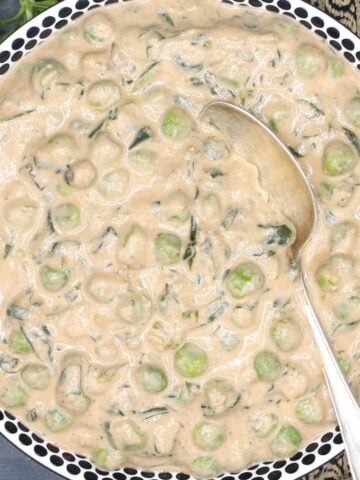
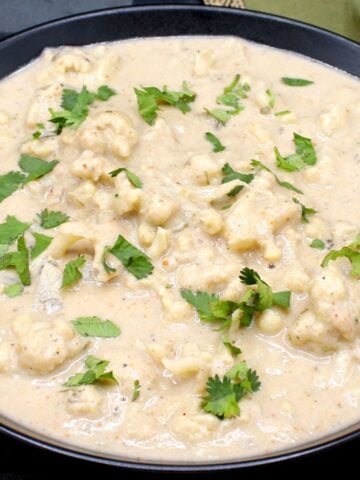
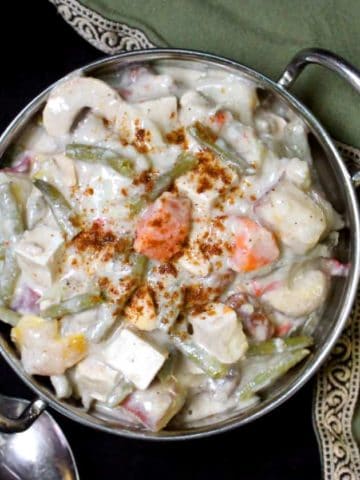
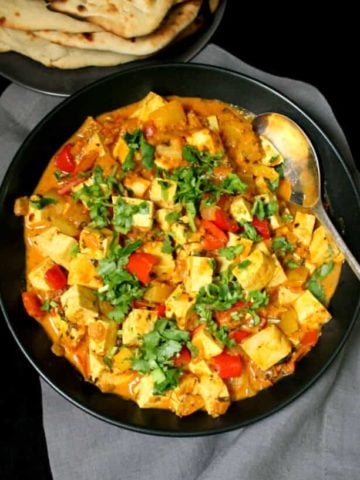
Pauline
Made this last night and omg, fantastic! Definitely company food!
I forgot the cornstarch, but being that they sat awhile waiting for the oil to heat up - they cooked perfectly, I was lucky.
The sauce was so good too!
This makes a lot, so I'm experimenting with freezing the left overs. And use my airfryer to reheat the balls.
Thank you!
Vaishali
Hi Pauline, So happy the recipe worked for you! Great idea with freezing leftovers and using the air fryer to reheat. Thanks for sharing those tips.
nicci parsons
assume we add the cloves and cardamon and cinnamon at same time as other spices?